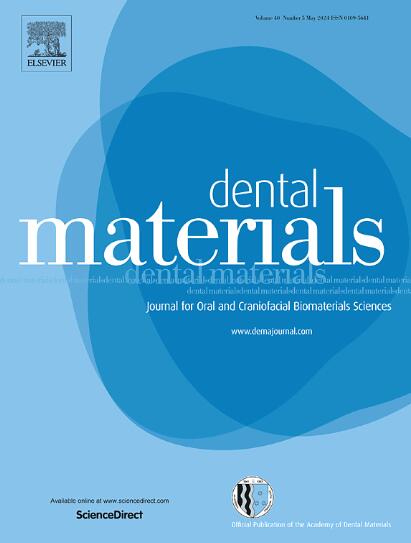Effect of phosphoric acid etching and blasting with aluminum oxide on the enamel topography and adhesion of resin composite to intact or abraded enamel
IF 4.6
1区 医学
Q1 DENTISTRY, ORAL SURGERY & MEDICINE
引用次数: 0
Abstract
Objectives
To evaluate the effects of the phosphoric acid (PA) etching, self-etching technique (SE) and blasting with Al2O3 particles (BL) on the bonding of a dental adhesive to intact (INT) or abraded (ABR) enamel.
Methods
Enamel surfaces were treated as follows: 1- ABR-PA: INT was abraded with SiC paper and etched with PA (20 s) before Clearfil Universal Bond Quick adhesive application; 2- ABR-SE: ABR was SiC and adhesive applied in SE mode; 3- INT-PA: INT was etched with PA and adhesive applied; 4- INT-SE: the adhesive (SE mode) was applied to INT; 5- INT-BL: INT was BL and the adhesive was applied (SE mode), and 6- INT-BA: INT was BL, etched with PA and adhesive applied (SE mode). The enamel surface treated was examined with scanning electron microscopy (SEM) (n = 3) and Al2O3 particles were characterized using SEM and EDX. The enamel bond strength was measured by microtensile test (24 h and 1 year) (n = 8) and the morphology of enamel-adhesive interfaces were analyzed by SEM (n = 3). Bond strength data were analyzed by two-way ANOVA and Tukey’s test (α = 0.05).
Results
Al2O3 particles had an irregular shape, their length varied (50–20 µm) and the perimeter mean was 38.8 µm. The enamel morphology significantly influenced the enamel bond strength. ABR-PA, INT-BL, and INT-BA provided greater and stable enamel-dentin interaction and bond strength.
Significance
The enamel morphology significantly influenced the enamel bond strength. Using the adhesive in etch-and-rinse mode, enamel must be abraded before etching and must be Al2O3-blasted when used in SE mode.
磷酸蚀刻和氧化铝喷射对珐琅质形貌以及树脂复合材料与完整或磨损珐琅质粘附性的影响。
目的评估磷酸(PA)腐蚀、自酸洗技术(SE)和氧化铝颗粒喷射(BL)对牙科粘合剂与完整(INT)或磨损(ABR)珐琅质粘合的影响:珐琅质表面的处理方法如下:1- ABR-PA:1- ABR-PA:在使用 Clearfil 通用粘接快速粘接剂之前,用碳化硅纸研磨 INT 并用 PA 进行蚀刻(20 秒);2- ABR-SE:ABR 为碳化硅,粘接剂以 SE 模式使用;3- INT-PA:4- INT-SE:在 INT 上涂抹粘合剂(SE 模式);5- INT-BL:INT 为 BL,涂抹粘合剂(SE 模式);6- INT-BA:INT 为 BL,涂抹 PA,涂抹粘合剂(SE 模式)。用扫描电子显微镜(SEM)对处理过的珐琅质表面进行检测(n = 3),并用 SEM 和 EDX 对 Al2O3 颗粒进行表征。通过显微拉伸试验(24 小时和 1 年)测量了珐琅质粘接强度(n = 8),并用扫描电镜分析了珐琅质与粘接剂界面的形态(n = 3)。粘接强度数据采用双因素方差分析和 Tukey 检验(α = 0.05):结果:Al2O3 颗粒形状不规则,长度不一(50-20 µm),平均周长为 38.8 µm。珐琅质形态对珐琅质粘接强度有明显影响。ABR-PA、INT-BL和INT-BA提供了更大更稳定的珐琅质-牙本质相互作用和粘接强度:珐琅质形态对珐琅质粘接强度有重要影响。在蚀刻-冲洗模式下使用该粘合剂时,必须在蚀刻前对珐琅质进行研磨,在 SE 模式下使用时,必须对珐琅质进行 Al2O3 喷砂处理。
本文章由计算机程序翻译,如有差异,请以英文原文为准。
求助全文
约1分钟内获得全文
求助全文
来源期刊

Dental Materials
工程技术-材料科学:生物材料
CiteScore
9.80
自引率
10.00%
发文量
290
审稿时长
67 days
期刊介绍:
Dental Materials publishes original research, review articles, and short communications.
Academy of Dental Materials members click here to register for free access to Dental Materials online.
The principal aim of Dental Materials is to promote rapid communication of scientific information between academia, industry, and the dental practitioner. Original Manuscripts on clinical and laboratory research of basic and applied character which focus on the properties or performance of dental materials or the reaction of host tissues to materials are given priority publication. Other acceptable topics include application technology in clinical dentistry and dental laboratory technology.
Comprehensive reviews and editorial commentaries on pertinent subjects will be considered.
 求助内容:
求助内容: 应助结果提醒方式:
应助结果提醒方式:


